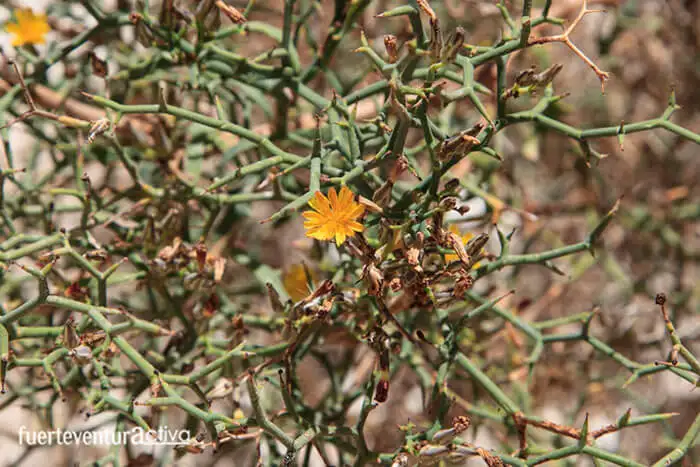LIFE IN FUERTEVENTURA, What to see in Fuerteventura ?
Gorse (La Aulaga)
If we were to sketch the landscape of Fuerteventura, it would surely include goats and gorse. These two elements have been very present in the life of the Majoreros since time immemorial. Today we dedicate this article to gorse, one of the most abundant plants on the island, if not the most abundant, and which has colonized all of Fuerteventura.
The Canarian gorse (Launaea arborescens) is a shrubby plant, up to 1 meter high. It is characterized by its network of thorns, its tiny leaves and its small yellow flowers that grow mostly solitary.
Canarian gorse should not be confused with those of the rest of the country, as they are very different. In the mainland gorse is called a varied type of thorny shrub with yellow flowers. There are both gorse belonging to the genus genistas as well as the ulex.
After the European conquest, the people who populated the islands called gorse our unique thorny bushes, perhaps because they were reminded of the peninsular plants.

Uses of gorse.
There is a saying in Spanish that goes something like this: “From the pig you can take advantage of everything, even its gait.” We could say the same about gorse. It has been the multipurpose plant par excellence in Fuerteventura. Its use ranges from the most elementary as combustion material, to medicinal purposes.
Gorse in art
Some muse has to inhabit the interior of this plant, so that it has inspired both plastic artists and literati.
For example, the artist Eli Griffiths, creates mesmerizing landscapes of gorse painted by hand and inserted into bottles, light bulbs or other elements. They are not just simple decorative objects. Observing these mini-worlds makes us ask ourselves multiple doubts that transcend beyond the object. We could be watching them for hours and we would always find something new in them.
As for literature, no one better than the playwright Miguel de Unamuno to tell us about gorse, which according to him were: “skeleton of a thorny plant”.

Gorse as a combustion material.
Due to the scarcity of forested material in Fuerteventura, gorse has been used mainly for cooking. Due to their high calorific value, they have been highly demanded by bakers and potters.
It was also the raw material to feed the lime kilns. In fact, it is known that for every ten bushels of lime, a camel load of gorse was required to be burned.
Both in the obtaining of the stone of barilla, as in the one of lime, the combustion of wood was necessary. The demand was so great that the felling of gorse for use in kilns was prohibited in the middle of the 19th century.
The person who was caught with a load of gorse cut without a license, was fined and all firewood confiscated.
Gorse to preserve food

The gorse was used to make the “corridor”, very useful for drying figs. The gorse are spread on the ground, they are lightly pressed trying to make them evenly placed. The figs are put on the gorse to dry.
Thanks to the physiognomy of gorse, it allows the last fig to aerate, avoiding rotting in the drying process. The gorse must be dry, as the green gorse gives off a bitter latex that can affect the taste of the dried fruit.
Gorse to dry mussels and fish.
This is one of the oldest techniques for preserving seafood. Once cleaned, the mussels are placed together in rows on a flat stone, whiskers down. On top are the gorse. As with figs, the very nature of gorse allows aeration of the fish avoiding, not only, rot in the drying process, but also that seagulls and flies get close
Gorse as a filter.
The waters that have been used for the most part, in Fuerteventura, have been those of rain. When it rains it does so in a torrential way, dragging materials capable of clogging the pipes.
Very effective filters were made with gorse. These plants were pressed and compacted, giving with the feet, the appropriate shape in order to adapt it to the entrance hole of the portholes, portholes and cisterns, preventing stones and branches from entering.
Gorse in the livestock world of Fuerteventura.

Due to its network of thorns, gorse was used to surround the farms, making them impenetrable for livestock.
With the same purpose, that of serving as a natural fence, gorse is used in shrimp, during the battered ones. A few good bushes of gorse and hawthorn are placed all over the parapet of the shrimp. This prevents large goats from jumping over shrimp. This technique is also used to prevent baby goats from getting out or to prevent crows from approaching.
Gorse have galactogenic properties (they favor milk production), which is why they are part of the diet of goats, but not in large quantities, since the bitterness of the plant is transmitted to the goat’s milk.
Even the names that the aborigines gave to the plant: oum el beina, um el beina and mulbeina, refer to it. They can be translated as “The mother of bad milk.”
Gorse in majorera folk medicine.
Gorse was even used for curative purposes. Not very effective, by the way. With the roots of gorse, a poultice was made that was put on the stomach. The popular belief that this method relieved tummy aches.
With the roots an infusion was made to lower blood sugar levels.
The infusion of gorse flowers was believed useful to cure jaundice, epilepsies and opilations. Gorse milk was used to dry boils.
But the uses of gorse do not end there. The dried flowers were used in the past to dye wool.
Fuerteventura3 Fuerteventura8






Comments are closed.